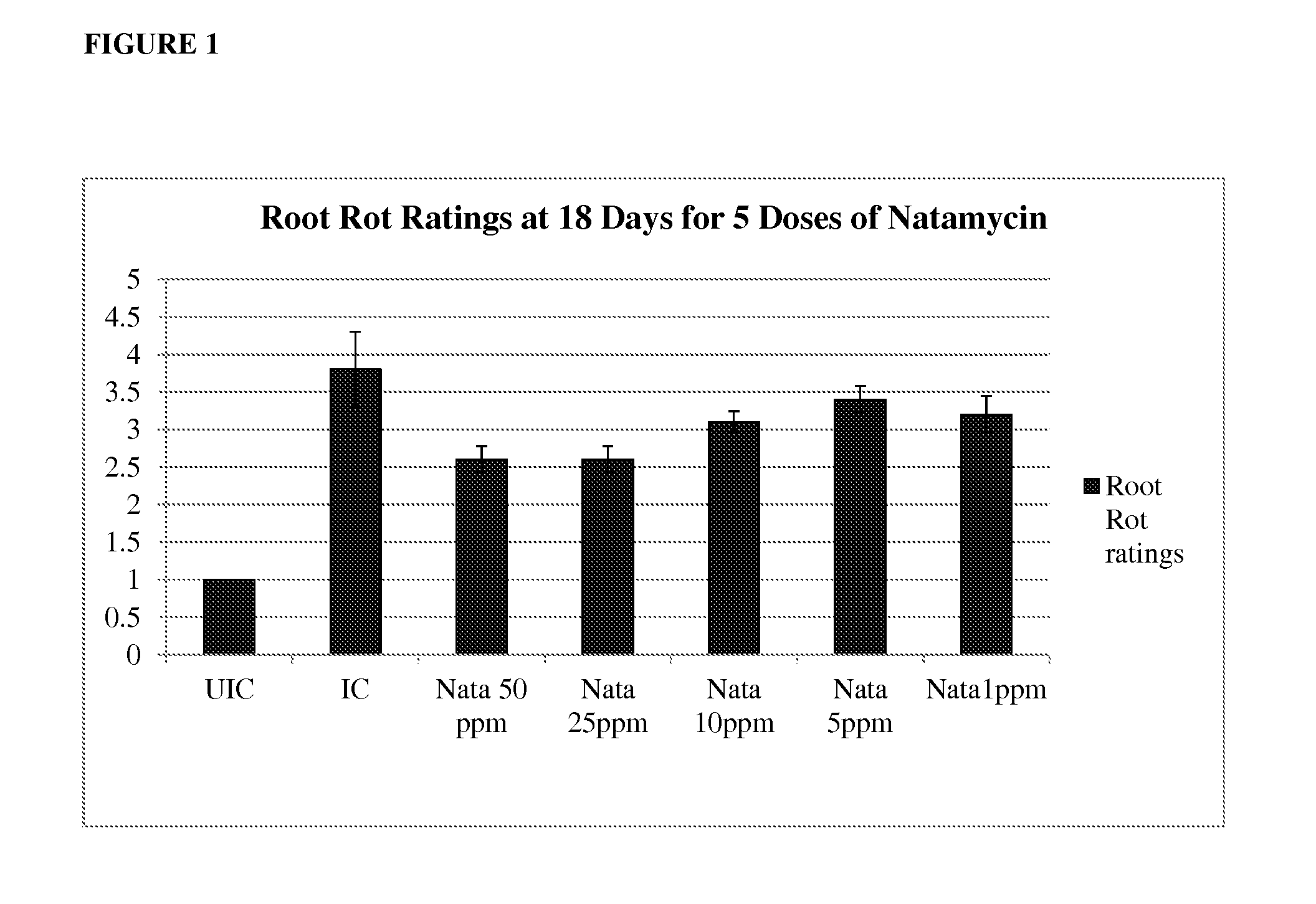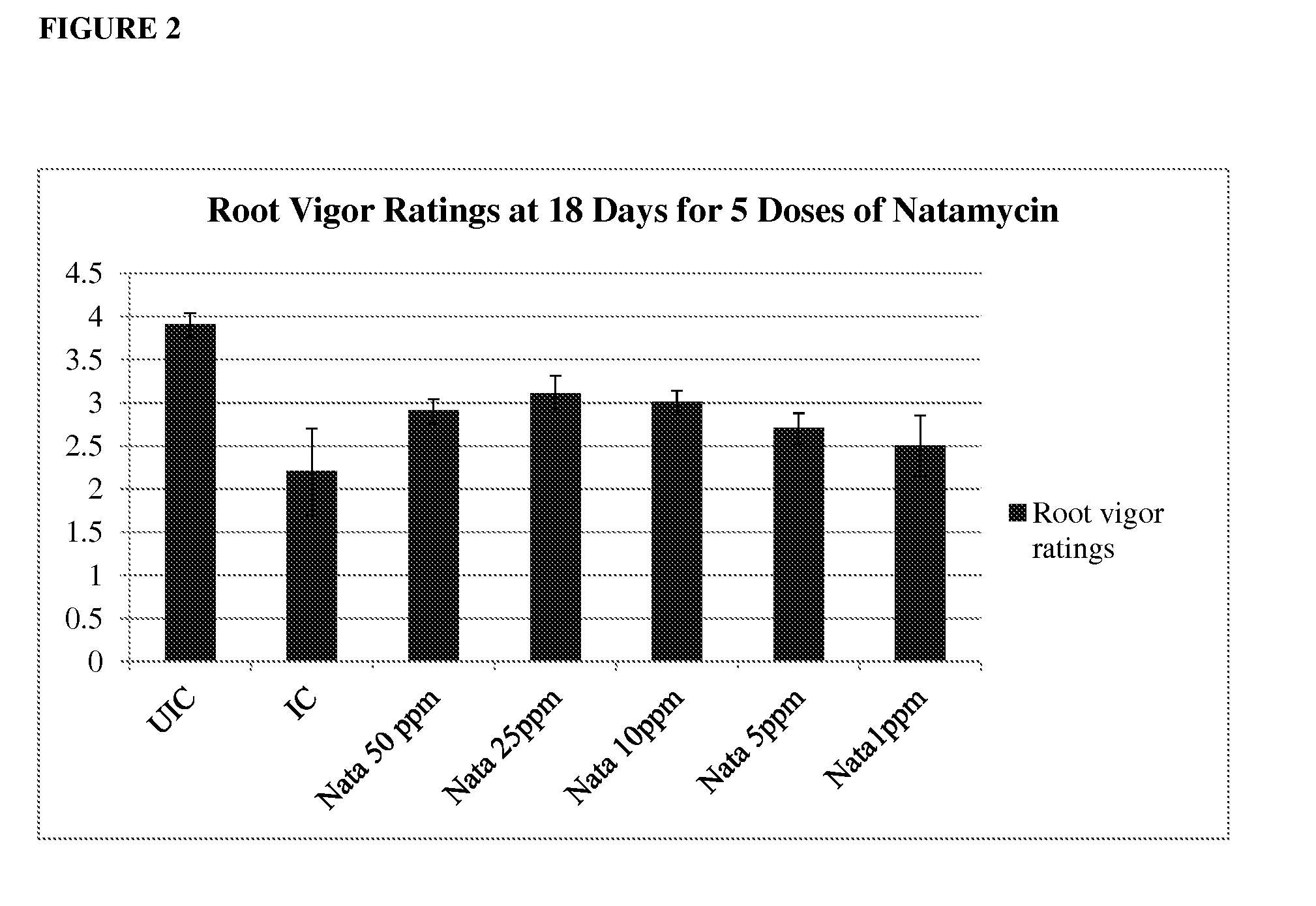Methods of controlling fungal pathogens using polyene fungicides
a technology of fungicides and fungal pathogens, applied in the field of fungal pathogen control, can solve the problems of molting/mosaic appearance, sds has been very problematic for the farming industry, and the disease is not readily observed in plants
- Summary
- Abstract
- Description
- Claims
- Application Information
AI Technical Summary
Benefits of technology
Problems solved by technology
Method used
Image
Examples
example 1
Different Concentrations of Natamycin were Assessed for Zones of Inhibition Against F. virguliforme in an Agar Diffusion Assay
[0078]A PDA plate containing two week old F. virguliforme was flooded with sterile distilled water and scraped with an L-rod to release spores. The spore solution was poured through about four layers of cheese cloth into a 50 mL conical tube. Spores were quantified using a hemacytometer, then diluted to 1×105 spores / mL. (1×104 spores were spread on plates.) To make F. virguliforme lawn plates, 100 μL of the spore suspension was spread onto commercial PDA plates. Wells were made for the F. virguliforme lawn plates using straw-plungers.
[0079]Natamycin stock was diluted in sterile distilled water to concentrations of 500 ppm, 250 ppm, 100 ppm, 50 ppm, 25 ppm, 12.5 ppm, 6.25 ppm, 3.13 ppm, 1.56 ppm, 0.78 ppm, and 0.4 ppm. 100 μL of each dilution was placed in a well on the lawn plates. Control plates consisted of a 1000 ppm plate, a water control, and a 70% ethan...
example 2
An in Planta Assay was Used to Assess Natamycin for Control of Sudden Death Syndrome of Soybean
[0081]Sorghum was prepared for inoculation. One to two liters of sorghum seed was put into spawn bags, autoclaved, then inoculated with 30-45 mL of an SDA spore suspension. Bags were left in a cupboard at room temperature, then shaken and mixed every few days for three weeks until ready. Sorghum inoculum was assessed for the number of spores per gram of seed by hemacytometer. The sorghum grew to 4.57×105 spores / g.
[0082]F. virguliforme spores were enumerated before soil inoculation. First, 25 mL of sterile 0.1% Tween 80 in water was added to sterile 50 mL conical tubes. The tubes where weighed. Then several grains of colonized sorghum from the spawn bag were aseptically added. The tubes were re-weighed to find the exact mass of colonized spores added to the tube. The tubes were shaken at 28-30° C. at approximately 250 rpm for 2-4 hours to release spores from the sorghum seed. Samples were t...
example 3
Testing Lower Concentrations of Natamycin as a Drench Treatment on Seedlings for Control of SDS in Planta
[0088]Using a protocol similar to that described in Example, 2 lower concentrations of natamycin, 50 ppm, 25 ppm, 10 ppm, 5 ppm, and 1 ppm, were assessed for the treatment of SDS. Two experiments were performed.
[0089]The natamycin solutions were used as a drench treatment with 50 mL of the solution applied to each container. Soy seedlings were transplanted into SDS infested soil, with SDS spores at a rate of 1×107 spores / container. The natamycin solutions were applied to the containers the day after transplant. Soy roots were washed after eighteen days.
[0090]FIGS. 1 and 2 show the results of the first experiment, and FIGS. 3 and 4 show the results of the second experiment. In particular, the data shows that the root rot ratings for natamycin treated plants at 50 ppm, 25 ppm, and 10 ppm per container were significantly lower (i.e., better) than the infested control (IC) plants and...
PUM
| Property | Measurement | Unit |
|---|---|---|
| concentration | aaaaa | aaaaa |
| general composition | aaaaa | aaaaa |
| composition | aaaaa | aaaaa |
Abstract
Description
Claims
Application Information
 Login to View More
Login to View More - R&D
- Intellectual Property
- Life Sciences
- Materials
- Tech Scout
- Unparalleled Data Quality
- Higher Quality Content
- 60% Fewer Hallucinations
Browse by: Latest US Patents, China's latest patents, Technical Efficacy Thesaurus, Application Domain, Technology Topic, Popular Technical Reports.
© 2025 PatSnap. All rights reserved.Legal|Privacy policy|Modern Slavery Act Transparency Statement|Sitemap|About US| Contact US: help@patsnap.com



